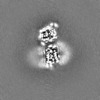+ Open data
Open data
- Basic information
Basic information
| Entry |  | |||||||||
|---|---|---|---|---|---|---|---|---|---|---|
| Title | Dopamine 1 receptor:GaS complex bound to 19B | |||||||||
 Map data Map data | ||||||||||
 Sample Sample |
| |||||||||
 Keywords Keywords | D1R / GS / AGONIST / PARKINSON / NEUROSCIENCE / D1R GS / HORMONE | |||||||||
| Function / homology |  Function and homology information Function and homology informationdopamine neurotransmitter receptor activity, coupled via Gs / dopamine neurotransmitter receptor activity / operant conditioning / cerebral cortex GABAergic interneuron migration / Dopamine receptors / dopamine binding / regulation of dopamine uptake involved in synaptic transmission / phospholipase C-activating dopamine receptor signaling pathway / peristalsis / heterotrimeric G-protein binding ...dopamine neurotransmitter receptor activity, coupled via Gs / dopamine neurotransmitter receptor activity / operant conditioning / cerebral cortex GABAergic interneuron migration / Dopamine receptors / dopamine binding / regulation of dopamine uptake involved in synaptic transmission / phospholipase C-activating dopamine receptor signaling pathway / peristalsis / heterotrimeric G-protein binding / modification of postsynaptic structure / G protein-coupled receptor complex / positive regulation of neuron migration / grooming behavior / habituation / regulation of dopamine metabolic process / sensitization / dopamine transport / astrocyte development / dentate gyrus development / striatum development / conditioned taste aversion / positive regulation of potassium ion transport / maternal behavior / arrestin family protein binding / positive regulation of mini excitatory postsynaptic potential / beta2-adrenergic receptor activity / negative regulation of smooth muscle contraction / non-motile cilium / AMPA selective glutamate receptor signaling pathway / positive regulation of autophagosome maturation / norepinephrine-epinephrine-mediated vasodilation involved in regulation of systemic arterial blood pressure / heat generation / norepinephrine binding / long-term synaptic depression / Adrenoceptors / mating behavior / adult walking behavior / positive regulation of lipophagy / negative regulation of multicellular organism growth / negative regulation of G protein-coupled receptor signaling pathway / ciliary membrane / G protein-coupled dopamine receptor signaling pathway / temperature homeostasis / endosome to lysosome transport / response to psychosocial stress / adrenergic receptor signaling pathway / diet induced thermogenesis / D-glucose import / dopamine metabolic process / transmission of nerve impulse / positive regulation of cAMP/PKA signal transduction / adenylate cyclase binding / smooth muscle contraction / PKA activation in glucagon signalling / developmental growth / G-protein alpha-subunit binding / hair follicle placode formation / G protein-coupled receptor signaling pathway, coupled to cyclic nucleotide second messenger / bone resorption / D1 dopamine receptor binding / potassium channel regulator activity / positive regulation of bone mineralization / intracellular transport / neuronal dense core vesicle / prepulse inhibition / positive regulation of synaptic transmission, glutamatergic / brown fat cell differentiation / behavioral fear response / vascular endothelial cell response to laminar fluid shear stress / neuronal action potential / renal water homeostasis / activation of adenylate cyclase activity / Hedgehog 'off' state / intercellular bridge / synapse assembly / adenylate cyclase-activating adrenergic receptor signaling pathway / regulation of sodium ion transport / behavioral response to cocaine / cellular response to glucagon stimulus / presynaptic modulation of chemical synaptic transmission / regulation of insulin secretion / receptor-mediated endocytosis / response to cold / response to amphetamine / adenylate cyclase activator activity / positive regulation of release of sequestered calcium ion into cytosol / trans-Golgi network membrane / synaptic transmission, glutamatergic / negative regulation of inflammatory response to antigenic stimulus / clathrin-coated endocytic vesicle membrane / bone development / G protein-coupled receptor activity / visual learning / GABA-ergic synapse / platelet aggregation / adenylate cyclase-modulating G protein-coupled receptor signaling pathway / memory / cognition / vasodilation Similarity search - Function | |||||||||
| Biological species |  Homo sapiens (human) Homo sapiens (human) | |||||||||
| Method | single particle reconstruction / cryo EM / Resolution: 2.8 Å | |||||||||
 Authors Authors | Clairfeuille T / Rodriguez Sarmiento RM | |||||||||
| Funding support | 1 items
| |||||||||
 Citation Citation |  Journal: J Med Chem / Year: 2025 Journal: J Med Chem / Year: 2025Title: Orally Bioavailable Dopamine D1/D5 Receptor-Biased Agonists to Study the Role of β-Arrestin in Treatment-Related Dyskinesia in Parkinson's Disease. Authors: Rosa María Rodríguez Sarmiento / Stefan Berchtold / Nenad Manevski / Lothar Lindemann / Fabian Dey / Thomas Clairfeuille / Davide Amendola / Nicolas Vautrelle / Venceslas Duveau / Eoin C O Connor /   Abstract: Dopamine replacement therapies for Parkinson's disease often produce dyskinesias with long-term use. Published studies suggest that introducing β-arrestin signaling might be protective for ...Dopamine replacement therapies for Parkinson's disease often produce dyskinesias with long-term use. Published studies suggest that introducing β-arrestin signaling might be protective for dyskinesia. We advanced known noncatecholamine D1/D5 receptor G protein-biased agonists and found that removal of oxygen in the linker from published compounds limited β-arrestin recruitment, whereas introduction of nitrogen on the central -phenyl linker favored β-arrestin recruitment and provided orally bioavailable compounds. Cryogenic electron microscopy suggested key receptor-ligand interactions influencing the different bias behaviors. We discovered compound , a D1/D5 receptor agonist with β-arrestin recruitment and properties for use . We compared with tavapadon, which shows weak efficacy for β-arrestin signaling, in a rat model of Parkinson's disease with L-DOPA-induced dyskinesias. At particular doses, compound produced efficacy comparable to L-DOPA, but with fewer concomitant dyskinesias. This first study suggests that β-arrestin may have a positive influence on reducing dyskinesias following acute administration. | |||||||||
| History |
|
- Structure visualization
Structure visualization
| Supplemental images |
|---|
- Downloads & links
Downloads & links
-EMDB archive
| Map data |  emd_52624.map.gz emd_52624.map.gz | 85.8 MB |  EMDB map data format EMDB map data format | |
|---|---|---|---|---|
| Header (meta data) |  emd-52624-v30.xml emd-52624-v30.xml emd-52624.xml emd-52624.xml | 22.8 KB 22.8 KB | Display Display |  EMDB header EMDB header |
| FSC (resolution estimation) |  emd_52624_fsc.xml emd_52624_fsc.xml | 9.5 KB | Display |  FSC data file FSC data file |
| Images |  emd_52624.png emd_52624.png | 107.6 KB | ||
| Masks |  emd_52624_msk_1.map emd_52624_msk_1.map | 91.1 MB |  Mask map Mask map | |
| Filedesc metadata |  emd-52624.cif.gz emd-52624.cif.gz | 7.3 KB | ||
| Others |  emd_52624_additional_1.map.gz emd_52624_additional_1.map.gz emd_52624_half_map_1.map.gz emd_52624_half_map_1.map.gz emd_52624_half_map_2.map.gz emd_52624_half_map_2.map.gz | 45.5 MB 84.6 MB 84.6 MB | ||
| Archive directory |  http://ftp.pdbj.org/pub/emdb/structures/EMD-52624 http://ftp.pdbj.org/pub/emdb/structures/EMD-52624 ftp://ftp.pdbj.org/pub/emdb/structures/EMD-52624 ftp://ftp.pdbj.org/pub/emdb/structures/EMD-52624 | HTTPS FTP |
-Validation report
| Summary document |  emd_52624_validation.pdf.gz emd_52624_validation.pdf.gz | 777.4 KB | Display |  EMDB validaton report EMDB validaton report |
|---|---|---|---|---|
| Full document |  emd_52624_full_validation.pdf.gz emd_52624_full_validation.pdf.gz | 777 KB | Display | |
| Data in XML |  emd_52624_validation.xml.gz emd_52624_validation.xml.gz | 17.7 KB | Display | |
| Data in CIF |  emd_52624_validation.cif.gz emd_52624_validation.cif.gz | 23.1 KB | Display | |
| Arichive directory |  https://ftp.pdbj.org/pub/emdb/validation_reports/EMD-52624 https://ftp.pdbj.org/pub/emdb/validation_reports/EMD-52624 ftp://ftp.pdbj.org/pub/emdb/validation_reports/EMD-52624 ftp://ftp.pdbj.org/pub/emdb/validation_reports/EMD-52624 | HTTPS FTP |
-Related structure data
| Related structure data |  9i52MC  9i54C M: atomic model generated by this map C: citing same article ( |
|---|---|
| Similar structure data | Similarity search - Function & homology  F&H Search F&H Search |
- Links
Links
| EMDB pages |  EMDB (EBI/PDBe) / EMDB (EBI/PDBe) /  EMDataResource EMDataResource |
|---|---|
| Related items in Molecule of the Month |
- Map
Map
| File |  Download / File: emd_52624.map.gz / Format: CCP4 / Size: 91.1 MB / Type: IMAGE STORED AS FLOATING POINT NUMBER (4 BYTES) Download / File: emd_52624.map.gz / Format: CCP4 / Size: 91.1 MB / Type: IMAGE STORED AS FLOATING POINT NUMBER (4 BYTES) | ||||||||||||||||||||||||||||||||||||
|---|---|---|---|---|---|---|---|---|---|---|---|---|---|---|---|---|---|---|---|---|---|---|---|---|---|---|---|---|---|---|---|---|---|---|---|---|---|
| Projections & slices | Image control
Images are generated by Spider. | ||||||||||||||||||||||||||||||||||||
| Voxel size | X=Y=Z: 0.934 Å | ||||||||||||||||||||||||||||||||||||
| Density |
| ||||||||||||||||||||||||||||||||||||
| Symmetry | Space group: 1 | ||||||||||||||||||||||||||||||||||||
| Details | EMDB XML:
|
-Supplemental data
-Mask #1
| File |  emd_52624_msk_1.map emd_52624_msk_1.map | ||||||||||||
|---|---|---|---|---|---|---|---|---|---|---|---|---|---|
| Projections & Slices |
| ||||||||||||
| Density Histograms |
-Additional map: #1
| File | emd_52624_additional_1.map | ||||||||||||
|---|---|---|---|---|---|---|---|---|---|---|---|---|---|
| Projections & Slices |
| ||||||||||||
| Density Histograms |
-Half map: #1
| File | emd_52624_half_map_1.map | ||||||||||||
|---|---|---|---|---|---|---|---|---|---|---|---|---|---|
| Projections & Slices |
| ||||||||||||
| Density Histograms |
-Half map: #2
| File | emd_52624_half_map_2.map | ||||||||||||
|---|---|---|---|---|---|---|---|---|---|---|---|---|---|
| Projections & Slices |
| ||||||||||||
| Density Histograms |
- Sample components
Sample components
-Entire : D1R complex with Gas and 19B
| Entire | Name: D1R complex with Gas and 19B |
|---|---|
| Components |
|
-Supramolecule #1: D1R complex with Gas and 19B
| Supramolecule | Name: D1R complex with Gas and 19B / type: complex / ID: 1 / Parent: 0 / Macromolecule list: #1-#4 |
|---|---|
| Source (natural) | Organism:  Homo sapiens (human) Homo sapiens (human) |
-Macromolecule #1: Beta-2 adrenergic receptor,D(1A) dopamine receptor
| Macromolecule | Name: Beta-2 adrenergic receptor,D(1A) dopamine receptor / type: protein_or_peptide / ID: 1 / Number of copies: 1 / Enantiomer: LEVO |
|---|---|
| Source (natural) | Organism:  Homo sapiens (human) Homo sapiens (human) |
| Molecular weight | Theoretical: 59.074711 KDa |
| Recombinant expression | Organism:  |
| Sequence | String: MDSKGSSQKG SRLLLLLVVS NLLLCQGVVS DYKDDDDKDM GQPGNGSAFL LAPNGSHAPD HDVTQERDEG GSENLYFQGG GSMRTLNTS AMDGTGLVVE RDFSVRILTA CFLSLLILST LLGNTLVCAA VIRFRHLRSK VTNFFVISLA VSDLLVAVLV M PWKAVAEI ...String: MDSKGSSQKG SRLLLLLVVS NLLLCQGVVS DYKDDDDKDM GQPGNGSAFL LAPNGSHAPD HDVTQERDEG GSENLYFQGG GSMRTLNTS AMDGTGLVVE RDFSVRILTA CFLSLLILST LLGNTLVCAA VIRFRHLRSK VTNFFVISLA VSDLLVAVLV M PWKAVAEI AGFWPFGSFC NIWVAFDIMC STASILNLCV ISVDRYWAIS SPFRYERKMT PKAAFILISV AWTLSVLISF IP VQLSWHK AKPTSPSDGN ATSLAETIDN CDSSLSRTYA ISSSVISFYI PVAIMIVTYT RIYRIAQKQI RRIAALERAA VHA KNCQTT TGNGKPVECS QPESSFKMSF KRETKVLKTL SVIMGVFVCC WLPFFILNCI LPFCGSGETQ PFCIDSNTFD VFVW FGWAN SSLNPIIYAF NADFRKAFST LLGCYRLCPA TNNAIETVSI NNNGAAMFSS HHEPRGSISK ECNLVYLIPH AVGSS EDLK KEEAAGIARP LEKLSPALSV ILDYDTDVSL EKIQPITQNG QHPTHHHHHH HH UniProtKB: Beta-2 adrenergic receptor, D(1A) dopamine receptor |
-Macromolecule #2: Guanine nucleotide-binding protein G(I)/G(S)/G(T) subunit beta-1
| Macromolecule | Name: Guanine nucleotide-binding protein G(I)/G(S)/G(T) subunit beta-1 type: protein_or_peptide / ID: 2 / Number of copies: 1 / Enantiomer: LEVO |
|---|---|
| Source (natural) | Organism:  Homo sapiens (human) Homo sapiens (human) |
| Molecular weight | Theoretical: 38.636199 KDa |
| Recombinant expression | Organism:  |
| Sequence | String: MGHHHHHHHH SELDQLRQEA EQLKNQIRDA RKACADATLS QITNNIDPVG RIQMRTRRTL RGHLAKIYAM HWGTDSRLLV SASQDGKLI IWDSYTTNKV HAIPLRSSWV MTCAYAPSGN YVACGGLDNI CSIYNLKTRE GNVRVSRELA GHTGYLSCCR F LDDNQIVT ...String: MGHHHHHHHH SELDQLRQEA EQLKNQIRDA RKACADATLS QITNNIDPVG RIQMRTRRTL RGHLAKIYAM HWGTDSRLLV SASQDGKLI IWDSYTTNKV HAIPLRSSWV MTCAYAPSGN YVACGGLDNI CSIYNLKTRE GNVRVSRELA GHTGYLSCCR F LDDNQIVT SSGDTTCALW DIETGQQTTT FTGHTGDVMS LSLAPDTRLF VSGACDASAK LWDVREGMCR QTFTGHESDI NA ICFFPNG NAFATGSDDA TCRLFDLRAD QELMTYSHDN IICGITSVSF SKSGRLLLAG YDDFNCNVWD ALKADRAGVL AGH DNRVSC LGVTDDGMAV ATGSWDSFLK IWNG UniProtKB: Guanine nucleotide-binding protein G(I)/G(S)/G(T) subunit beta-1 |
-Macromolecule #3: Guanine nucleotide-binding protein G(I)/G(S)/G(O) subunit gamma-2
| Macromolecule | Name: Guanine nucleotide-binding protein G(I)/G(S)/G(O) subunit gamma-2 type: protein_or_peptide / ID: 3 / Number of copies: 1 / Enantiomer: LEVO |
|---|---|
| Source (natural) | Organism:  Homo sapiens (human) Homo sapiens (human) |
| Molecular weight | Theoretical: 7.861143 KDa |
| Recombinant expression | Organism:  |
| Sequence | String: MASNNTASIA QARKLVEQLK MEANIDRIKV SKAAADLMAY CEAHAKEDPL LTPVPASENP FREKKFFCAI L UniProtKB: Guanine nucleotide-binding protein G(I)/G(S)/G(O) subunit gamma-2 |
-Macromolecule #4: Guanine nucleotide-binding protein G(s) subunit alpha isoforms short
| Macromolecule | Name: Guanine nucleotide-binding protein G(s) subunit alpha isoforms short type: protein_or_peptide / ID: 4 / Number of copies: 1 / Enantiomer: LEVO EC number: Hydrolases; Acting on acid anhydrides; Acting on GTP to facilitate cellular and subcellular movement |
|---|---|
| Source (natural) | Organism:  Homo sapiens (human) Homo sapiens (human) |
| Molecular weight | Theoretical: 45.755547 KDa |
| Recombinant expression | Organism:  |
| Sequence | String: MGCLGNSKTE DQRNEEKAQR EANKKIEKQL QKDKQVYRAT HRLLLLGAGE SGKSTIVKQM RILHVNGFNG EGGEEDPQAA RSNSDGEKA TKVQDIKNNL KEAIETIVAA MSNLVPPVEL ANPENQFRVD YILSVMNVPD FDFPPEFYEH AKALWEDEGV R ACYERSNE ...String: MGCLGNSKTE DQRNEEKAQR EANKKIEKQL QKDKQVYRAT HRLLLLGAGE SGKSTIVKQM RILHVNGFNG EGGEEDPQAA RSNSDGEKA TKVQDIKNNL KEAIETIVAA MSNLVPPVEL ANPENQFRVD YILSVMNVPD FDFPPEFYEH AKALWEDEGV R ACYERSNE YQLIDCAQYF LDKIDVIKQA DYVPSDQDLL RCRVLTSGIF ETKFQVDKVN FHMFDVGAQR DERRKWIQCF ND VTAIIFV VASSSYNMVI REDNQTNRLQ EALNLFKSIW NNRWLRTISV ILFLNKQDLL AEKVLAGKSK IEDYFPEFAR YTT PEDATP EPGEDPRVTR AKYFIRDEFL RISTASGDGR HYCYPHFTCS VDTENIRRVF NDCRDIIQRM HLRQYELL UniProtKB: Guanine nucleotide-binding protein G(s) subunit alpha isoforms short |
-Macromolecule #5: 6-(4-imidazo[1,2-a]pyridin-8-yl-2-methyl-phenyl)-1,5-dimethyl-pyr...
| Macromolecule | Name: 6-(4-imidazo[1,2-a]pyridin-8-yl-2-methyl-phenyl)-1,5-dimethyl-pyrimidine-2,4-dione type: ligand / ID: 5 / Number of copies: 1 / Formula: A1IZU |
|---|---|
| Molecular weight | Theoretical: 346.383 Da |
-Macromolecule #6: water
| Macromolecule | Name: water / type: ligand / ID: 6 / Number of copies: 2 / Formula: HOH |
|---|---|
| Molecular weight | Theoretical: 18.015 Da |
| Chemical component information | 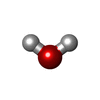 ChemComp-HOH: |
-Experimental details
-Structure determination
| Method | cryo EM |
|---|---|
 Processing Processing | single particle reconstruction |
| Aggregation state | particle |
- Sample preparation
Sample preparation
| Buffer | pH: 7.5 |
|---|---|
| Grid | Model: UltrAuFoil R1.2/1.3 / Material: GOLD / Mesh: 300 |
| Vitrification | Cryogen name: ETHANE / Chamber humidity: 95 % / Chamber temperature: 283 K / Instrument: LEICA PLUNGER |
- Electron microscopy
Electron microscopy
| Microscope | JEOL CRYO ARM 300 |
|---|---|
| Image recording | Film or detector model: GATAN K3 (6k x 4k) / Average electron dose: 40.0 e/Å2 |
| Electron beam | Acceleration voltage: 300 kV / Electron source:  FIELD EMISSION GUN FIELD EMISSION GUN |
| Electron optics | Illumination mode: FLOOD BEAM / Imaging mode: BRIGHT FIELD / Nominal defocus max: 2.5 µm / Nominal defocus min: 0.5 µm |
 Movie
Movie Controller
Controller









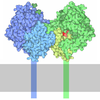
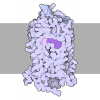
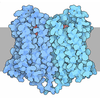
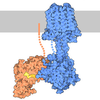








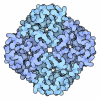
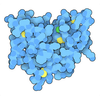




 Z (Sec.)
Z (Sec.) Y (Row.)
Y (Row.) X (Col.)
X (Col.)








































